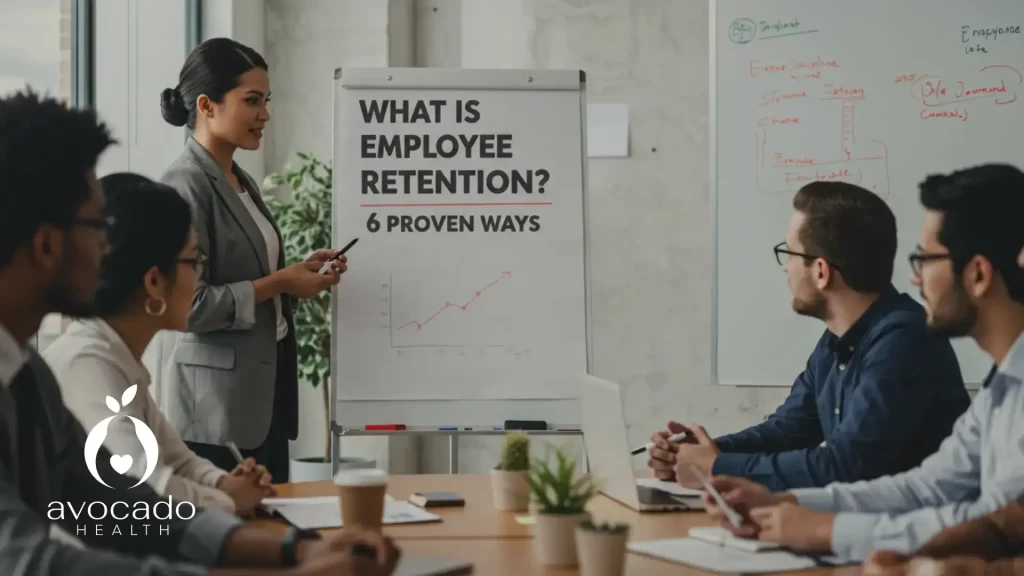Dad of 5. CEO & Co-Founder of Avocado Health. Former HealthTech & FinTech Founder. Passionate about empowering families and driving change in parenting and child development.

In today’s fast-paced job market, businesses are constantly facing a critical challenge with employee retention: keeping their top talent. Every employee who leaves takes valuable skills, experience, and workplace knowledge with them.
For companies, frequent employee departure isn’t just a minor inconvenience—it’s a costly disruption that affects productivity, morale, and overall business success. Implementing effective employee retention strategies is essential to mitigate these costs and ensure organizational success.
Table of Contents
What Is Employee Retention?

Employee retention refers to a company’s ability to keep its workforce intact by minimizing the number of employees who leave within a specific time frame, whether by choice or due to organizational decisions. It plays a crucial role in maintaining stability, productivity, and overall business success.
What Are the Major Causes of Employee Turnover?
Employee turnover doesn’t happen in a vacuum—it’s usually the result of workplace frustrations that build up over time, eventually pushing talented individuals out the door. Here are some of the biggest reasons employees decide to leave:
1. Low Pay and Inadequate Benefits

Money matters. If employees feel underpaid or lack essential benefits, they won’t hesitate to explore other options. Competitive salaries, health insurance, retirement plans, and paid leave aren’t just perks—they’re fundamental to keeping employees engaged and committed.
2. Limited Career Growth Opportunities

Nobody wants to feel stuck. When employees don’t see a clear path for career advancement, mentorship, or promotions, they start looking elsewhere. If there’s no opportunity to develop new skills or advance within the company through career development opportunities, they’ll find an employer that invests in their future.
3. Burnout and Work Overload
When workloads pile up and work-life balance disappears, stress and exhaustion take over. Employees who constantly feel overwhelmed and undervalued won’t stick around—they’ll prioritize their well-being by moving to a company that respects their time and energy.
4. Poor Onboarding and Training
First impressions matter. A confusing or disorganized onboarding process can leave new hires feeling lost, unprepared, and disengaged from the start. Without the proper training and support, they may quickly decide the company isn’t the right fit and leave before they ever get fully settled.
5. Ineffective or Toxic Management
People don’t just leave jobs—they leave bad bosses. A micromanaging, unsupportive, or uncommunicative manager can create a toxic environment that makes employees dread coming to work. Strong, empathetic leadership is key to keeping teams motivated and loyal.
6. Lack of Recognition and Appreciation
Employees want to feel valued for their contributions. When hard work goes unnoticed, motivation drops.
When appreciation is lacking, employee morale suffers, and employees will seek an employer who truly sees their worth. But why does employee retention matter now more than ever?
The Consequences of High Employee Turnover
Why Retention Should Be a Priority for Employers
High employee turnover isn’t just an inconvenience—it’s a costly, time-consuming, and disruptive problem that weakens a company’s long-term success. If not addressed,frequent employee departures can spiral out of control, impacting many aspects of the business.
1. Turnover Drains Company Finances
Hiring is expensive. The process of recruiting, interviewing, onboarding, and training a new employee can cost anywhere from 50% to 200% of their annual salary. For employers, this means that every resignation takes a significant financial toll, diverting money and resources away from business growth.
Beyond direct hiring costs, hidden expenses such as lost productivity, knowledge gaps, and training time further amplify the financial impact of turnover. For example, when a skilled employee leaves, their expertise doesn’t transfer overnight—it takes months (or longer) for a new hire to reach the same level of efficiency.
2. Productivity and Team Performance Take a Hit
When employees leave, their work doesn’t disappear—it falls on the shoulders of remaining team members, increasing workloads, slowing down projects, and leading to missed deadlines.
For businesses that rely on collaboration, sales relationships, or client trust, turnover can be especially damaging. Customers and clients often form connections with individual employees, and when those employees leave, customer confidence may decline.
If turnover is high, businesses risk losing not just employees but also valuable client relationships and revenue opportunities.
This is particularly important when considering working parents as part of the workforce. Many experienced professionals who are also parents bring a wealth of knowledge and strong organizational skills.
If businesses fail to offer supportive policies—such as flexible work arrangements or parental benefits—they risk losing high-performing talent to competitors that do.
3. Employee Burnout and Low Morale Lead to More Exits
High turnover often creates a chain reaction—as more employees leave, those who stay are left with heavier workloads, longer hours, and increased pressure to compensate for missing team members. This leads to burnout, frustration, and disengagement, pushing even more employees toward the exit door. In contrast, motivated employees are more likely to stay engaged and productive, reducing the overall turnover rate.
- 41% of employees cite staff shortages as a top reason for burnout.
- 80% of employees have experienced burnout in the past year.
- The U.S. economy loses $500 billion annually due to workplace stress.
For employers, addressing burnout is essential—especially for working parents, who often balance both job responsibilities and family demands. Companies that fail to recognize these challenges risk losing employees who simply can’t sustain the pressure.
4. A High Turnover Reputation Makes Hiring Harder
In today’s job market, a company’s reputation means everything. Job seekers do their research before applying, and if they notice a pattern of employees frequently leaving, it raises red flags and makes them think twice about joining. They may start asking themselves:
- Is this company unstable?
- Are employees overworked and undervalued?
- Are professional growth opportunities limited here?
A company struggling with turnover won’t just lose current employees—it will also struggle to attract top talent. And for working parents in particular, job stability and flexibility are major factors in deciding where to work.
If a company has a reputation for constantly losing employees and failing to offer work-life balance, it risks losing some of the most skilled and experienced professionals in the workforce.
5. Losing Institutional Knowledge Hurts Long-Term Success
Every employee who leaves takes more than just their workload—they take institutional knowledge, industry experience, and established relationships. In fact:
- 42% of job-specific knowledge exists only in employees’ heads.
- 60% of employees say it’s difficult to obtain vital job information after a coworker leaves.
- Replacing an experienced worker can take up to a year before a new hire reaches full productivity.
High turnover forces companies to constantly rebuild knowledge and retrain employees, creating inefficiencies that slow down innovation and decision-making. For employers, this is an expensive and avoidable problem—one that can be solved by focusing on retention efforts and employee engagement.
How much is turnover really costing your business?

$1.8 trillion—that’s how much U.S. businesses lose annually due to lost productivity, recruitment expenses, and training new hires. If your company has a 20% turnover rate, how much money is slipping through the cracks? Could those resources be better spent on competitive salaries, better benefits, and creating a workplace where employees want to stay?
The numbers speak for themselves—retention isn’t just about culture; it’s a financial strategy. Investing in retention reduces costs, boosts engagement, and strengthens your bottom line.
So, Can your business afford NOT to focus on retention?
But beyond saving money, strong retention efforts also increase employee engagement, creating a more motivated and committed workforce. So, what drives employees to stay?
6 Key Factors That Drive Employee Retention
Retaining top talent isn’t just about offering a paycheck. In today’s competitive job market, companies that fail to prioritize retention risk losing their best employees to organizations that do. So, what truly keeps employees engaged and committed for the long haul?
Here are the key factors that can make or break your company’s ability to retain top talent:
1. Career Growth, Mentorship, and Development

Employees don’t just want a job—they want a future. When there’s no clear path for advancement, they start looking elsewhere for opportunities to grow. Providing mentorship, training, and career development programs shows your team that you’re invested in their success.
Mentorship, in particular, creates meaningful connections between employees and leaders, offering guidance, support, and a sense of direction. A company that prioritizes professional growth and mentorship retains its best talent, builds stronger, more capable leaders from within, and helps boost retention.
2. Work-Life Balance That Actually Works

Burnout is real, and employees are no longer willing to trade their well-being for a paycheck. When work takes over their lives, they eventually look for an employer that respects their time and values work-life balance.
Promoting work-life balance isn’t just about offering remote work or flexible hours—it’s about creating an environment where employees can do their best work without sacrificing their personal lives. When companies get this right, employees stay longer, feel more engaged, and bring their best selves to work every day.
3. A Strong Company Culture and Sense of Belonging
A company’s culture isn’t just about team lunches and office perks—it’s about creating a workplace where employees experience respect, feel heard, and stay aligned with the company’s mission.
Employees want to work for organizations that prioritize inclusivity, teamwork, and strong leadership.
4. Recognition and Appreciation

Feeling valued is a basic human need. Employees who work hard without recognition will quickly feel invisible and disengaged.
Companies that implement employee recognition programs, incentives, and rewards as part of their broader employee retention programs foster loyalty, motivation, and a sense of purpose. People don’t leave jobs where they feel appreciated and seen—they stay and thrive.
5. Flexibility and Adaptability
Rigid workplace policies push employees away. Today’s workforce values flexibility—whether it’s in how they work, where they work, or how they grow within the company.
Employers that adapt to the changing needs of their employees—by offering hybrid work models, parental leave, or personalized career paths—not only gain a competitive edge but also increase retention. Employees who feel trusted to manage their work in a way that suits them are more engaged and loyal.
6. Strong Leadership and Supportive Mentorship
Employees don’t leave jobs—they leave bad managers. Leadership plays a critical role in retention, and poor management can drive top talent away. Employees need leaders who listen, provide guidance, and inspire confidence.
A mentorship culture within leadership fosters growth, trust, and a strong sense of direction. Leaders who invest in mentorship relationships not only develop their teams but also build a work environment that encourages long-term commitment.
The Secret to Retention: The 5Cs, 3Rs, and 4 Pillars
Beyond these core factors, several well-known frameworks can help guide retention strategies:
- The 5Cs of Employee Engagement: Career, Community, Clarity, Convey, and Connect—helping employees stay engaged and purposeful.
- The 3Rs of Retention: Respect, Recognition, and Reward—creating a work culture that attracts and retains top talent.
- The 4 Pillars of Retention: Well-being, Workplace Culture, Training & Development, and Recognition—ensuring employees are supported and motivated.
At the end of the day, employees don’t leave companies—they leave environments that don’t support them.
How do companies benefit from employee retention?
Employee retention isn’t just about keeping people around—it’s about building a better, more profitable and more efficient business. When people stay, companies thrive. Here’s why investing in retention is one of the smartest things you can do:
Retaining valuable employees is crucial for organizational success, as it ensures that the company maintains its key talent and continues to benefit from their skills and experience.
1. More Productivity and Efficiency

Experienced people don’t just work faster—they work smarter. When people stay with your company long term they develop deep expertise, stronger collaboration and a thorough understanding of the business which means higher productivity and efficiency. On the other hand replacing employees slows down projects, creates knowledge gaps and results in wasted time training new recruits.
2. Lower Recruiting and Training Costs
Every resignation comes with a price tag. Recruiting, hiring and training new employees is expensive—let alone the lost productivity while a new recruit gets up to speed.
Retaining employees means lower recruitment costs, less downtime and more resources to invest in business growth rather than constantly filling vacancies.
3. Better Customer Experience
Customers notice high turnover—and not in a good way. Employees who stay build strong relationships with customers, understand their needs and provide consistent service. Frequent turnover disrupts that continuity, results in frustrated customers, poor service and lost business.
A stable workforce means better customer interactions, engagement and loyalty—ultimately better customer satisfaction.
4. Higher Morale and Employee Engagement
When employees see their colleagues leaving all the time it creates uncertainty, stress and lower morale. A stable workforce means a sense of community, trust and teamwork. Employees who feel secure in their role are more engaged, motivated and committed to the company’s success.
5. A Stronger, More Positive Organizational Culture
Organizational culture isn’t built overnight—it’s shaped by the people who work there every day. Significant turnover makes it almost impossible to build a strong, positive organizational culture.
Retaining employees means you can build a culture where people feel valued, connected, and inspired to contribute—which, in turn, makes the company more attractive to top talent.
6. More Profit and Long Term Growth
Retention impacts the bottom line. Lower turnover means less recruitment costs, better operational efficiency and a team that keeps getting better not starting from scratch. Companies that focus on retention see higher profits, better innovation and long term business success.
The choice is simple—prioritize retention and grow your business or ignore it and pay the price in lost talent, lost time and lost profits.
Retention Is an Investment, Not an Expense
Who Is Responsible for Employee Retention?
Many employers think employee retention is an HR issue, but the reality is—it’s a company-wide problem. While HR recruits the right talent and sets up workplace policies, keeping employees engaged, motivated and committed is a shared responsibility from leadership to frontline managers to coworkers.
Leaders Set the Tone
Employee retention starts at the top. Executives and senior leaders shape the workplace culture and define the values and policies that influence whether employees perceive themselves as valued or overlooked.
When leadership prioritizes a supportive work environment,and employee wellbeing then retention rates will improve. But if leadership ignores these factors then employees will start looking elsewhere.
A strong employee retention strategy set by leaders is crucial for managing workforce stability and productivity, ensuring that the company can effectively mitigate the costs associated with turnover.
Managers Hold the Key to Daily Engagement
A company can have great policies but if employees don’t feel supported by their direct manager they won’t stay. People don’t leave jobs they leave bad managers. How managers communicate, feedback and create opportunities for growth directly affects employee satisfaction. A manager who recognises achievements, develops professionally and listens to concerns can turn an average job into a career.
HR Supports the Foundation
HR’s role in retention is to support the foundation by hiring the right people, develop competitive compensation packages and create a positive work environment. But even the best HR strategies will fail if leadership and management don’t back them up.
Retention Is Everyone’s Job
From top executives to team leaders and HR professionals, every level of the organization plays a role in retention and reducing turnover. When employees feel valued, supported, and see a future in the company, they’ll be far more likely to stay.
How Do You Measure Retention?

You can’t improve what you don’t measure. Tracking retention metrics gives employers valuable insights into workforce stability and the effectiveness of retention strategies.
One key tool in this process is exit interviews, which provide valuable insight into why employees are leaving. A well-defined retention strategy is crucial for measuring and improving employee retention, ensuring that management practices are aligned with organizational goals..
1. Retention Rate: The Big Picture
The retention rate tells you what percentage of your workforce stays over a given period. It’s calculated by:
(Total Employees−Employees Who Left)×100 /Total Employees A high retention rate suggests a stable, engaged workforce, while a low retention rate signals potential issues with culture, leadership, or benefits. Understanding employee retention rates is crucial for making informed business decisions and improving workforce stability.
2. Turnover Rate: The Other Side of the Coin
The flip side of retention is the turnover rate, which measures how often employees depart. Tracking voluntary vs. involuntary turnover can reveal deeper problems. Are people quitting because they feel undervalued? Or is the company struggling with performance-related terminations?
3. Average Employee Tenure: Are People Sticking Around?
How long do employees stay with your company? A longer tenure often indicates strong engagement, and job satisfaction, while short tenures may suggest poor onboarding, weak management, or a lack of growth potential.
4. New Hire Retention Rate: Are You Losing Fresh Talent?
If new hires are leaving within the first 6 to 12 months, it’s a red flag. High early turnover often points to issues in the hiring process, poor onboarding, or unmet job expectations.
Why These Metrics Matter
Measuring employee retention isn’t just about numbers—it’s about identifying trends, diagnosing problems, and making strategic improvements.
If employees are constantly leaving and not staying long, it’s a sign that something isn’t working. Companies should take a closer look at why people are walking away and what changes can make them want to stay.
So, Is your company ready to make employee retention a priority?
You might also be interested in:
Presenteeism: Are Your Parent Employees Truly Present—Or Just Surviving?

